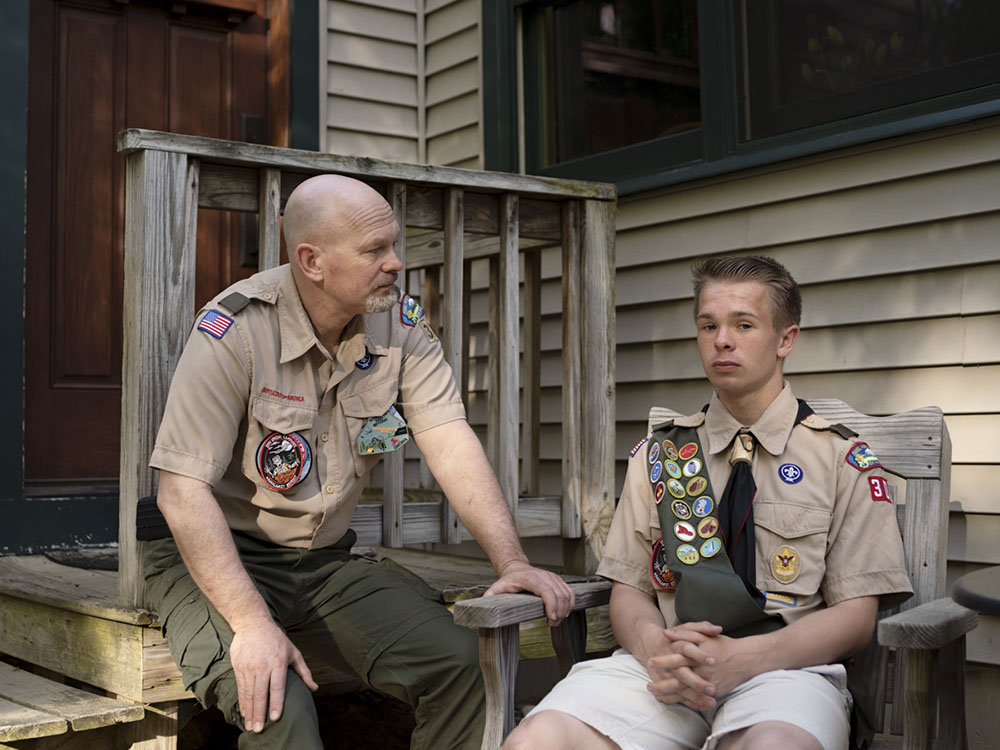by Renny Pritikin

The story feels like a fable. A young photojournalist, Preston Gannaway, assigned to cover a human-interest story in rural New Hampshire, goes into the woods, and her life is changed forever. While covering the struggles of the rural St. Pierre family over time, she becomes a member of the household. Her photographic journal of the eventual cancer death of the young mother of three and the subsequent life of her four-year-old son EJ becomes an ongoing part of her life’s work. She won a Pulitzer Prize for it in 2008.
Gannaway, 46, now lives in Sonoma County but was born and grew up in North Carolina, where both her mother and grandmother were artists. She graduated from Virginia Intermont College in 2000 and took a succession of jobs at small newspapers in Virginia and New Hampshire, as well as at the prestigious Rocky Mountain News in Colorado. Today, Gannaway’s photojournalism appears in The New Yorker, Time, The New York Times Magazine and The Atlantic. It is included in the permanent collections of the High Museum of Art, the Museum of Fine Arts Houston, Stanford and Duke University museums.

Gannaway’s project involves deeply immersing herself in subjects for long periods. Her kind of embeddedness, a term associated most recently with combat photographers in the Middle East, does not involve putting herself in physical danger, but it does expose her—and the viewer—to emotional vulnerability. Her first book, Between the Devil and the Deep Blue Sea, examines the unusual demographics of a beachside community near Norfolk, Virginia, where Gannaway lived for four years beginning in 2009. A site of unusually stunning seascapes, it attracts wealthy, older white residents alongside less affluent Black people in an awkward balance. In that project and others, such as Farms of West Oakland, her eclectic images, relentlessly humanistic and never ironic or cynical, highlight people enjoying each other’s company. Working in the street photography tradition of capturing images on the fly, she constructs her photos with saturated color, frequently juxtaposed with a dramatic use of white space and consistent horizontality. Her working strategy brings together three elements: her long-term presence in a community, the suggestion of something profound to be apprehended just behind glimpses of everyday life, and the subtle, almost unseen tensions that accompany political and racial conflict and cooperation.
Twenty-eight mostly small archival pigment prints from the Remember Me project, begun in 2006, are now on view at Chung 24 Gallery in San Francisco. An iconic exemplar in the series, EJ in the Window, sets the stage for her investigation of transition as a central human experience. EJ (short for Elijah) is just four and leans bare-legged on a couch, hands outstretched, against a window that overlooks a gloriously sunlit forest. The cave-like living room in which he stands reveals, on close inspection, his mortally ill mother,

wrapped in a pink bathrobe, keeping an eye on him. This trope of a sunlit exterior seen through the doorway of a dark interior was made famous by John Ford in the last scene of his masterpiece, The Searchers. It connotes the tragic separation between those who will move into the future and those who will not.
Gannaway’s series takes its place among other landmark long-term photography endeavors: Nicholas Nixon’s portraits of his wife and her three sisters over 40 years in his epic Brown Sisters series and Sally Mann’s documentation of pivotal years of her children’s youth, using black-and-white, almost sepia tones to emphasize timelessness. More recently, artists using the same approach have explored the residents of a tiny Caribbean island, Nevis (Catherine Hyland of the UK); the gauchos of South America (Luis Fabini of Uruguay); and the people of Xinjiang in Western China (Patrick Wack of France).
Remember Me follows EJ from age four up through his graduation from high school, his child’s face growing into a young man’s physiognomy. Jarringly, though, that face remains haunted and withdrawn throughout these transitions, suggesting that trauma, once experienced, doesn’t dissipate. A safety razor poised on the beautiful young skin of his arched neck transforms the simple act of a boy’s pubescent rite

(Shaving #1) into something potentially dangerous. More explicitly, in Rope, EJ, at around ten, floats in a creek supported by a plastic life preserver. He’s panicked and cold. From the shore, his father, Rich, tosses the boy a lifeline. Through careful spatial positioning, the artist captures their fragile mutual dependence. Gannaway reiterates the intricate nature of the father-son relationship in other works like Rich and EJ in Boy Scouts uniforms. In this, Rich’s concerned expression indicates he’s there for EJ. EJ’s distance gaze, however, clearly shows he’s someplace else.
Exploding Diet Coke offers a humorous respite. A shaken bottle of soda shoots liquid six feet into the air. Gannaway’s fast shutter captures the explosion as a tree-like vertical object. EJ looks on in apparent wonderment, his growing body exploding upward, too.
Other images show the past forecasting the future. A photo of EJ on a tricycle he has outgrown shows him evolving from kid to tween. A high-angle shot, High School Graduation, Manchester, NH, shows students milling about in a schoolyard in graduation gowns. The figures are abstracted and isolated, circulating like leaves in a stream amid a dismal landscape of garbage bins, a batting cage and a graffitied boxcar sitting idle on a train track in the background.

One particularly moving strategy was to group six framed images into a set. Among these, we see young EJ as a teen dozing with only his face illuminated beneath blankets and, in another image, a female hand reaching out to stroke his cheek, intimating a missing maternal touch. In another picture, Rich plants a blooming cherry sapling soon after his wife’s death, while four-year-old EJ tosses soil from a pile into the air, as if from a freshly dug grave. Gannaway shows the pain this family endured and transcended without ever lapsing into sentimentality. She leaves us concerned for Elijah’s future, but she also gives us hope, indicating with those sun-soaked cherry blossoms that life, even through tragedy, barely pauses before moving on.
# # #
Preston Gannaway: “Remember Me” @ Chung 24 Gallery through May 18, 2024.
About the author: Renny Pritikin was the chief curator at The Contemporary Jewish Museum in San Francisco from 2014 to 2018. Before that, he was the director of the Richard Nelson Gallery at UC Davis and the founding chief curator at Yerba Buena Center for the Arts beginning in 1992. For 11 years, he was also a senior adjunct professor at California College of the Arts, where he taught in the graduate program in Curatorial Practice. Pritikin has given lecture tours in museums in Japan as a guest of the State Department, in New Zealand as a Fulbright Scholar, and visited Israel as a Koret Israel Prize winner. The Prelinger Library published his most recent book of poems, Westerns and Dramas, in 2020. He is the United States correspondent for Umbigo magazine in Lisbon, Portugal and the author of a recently published memoir, At Third and Mission: A Life Among Artists.

I can’t wait to see the show. Beautiful review.
A great story as well as terrific work.
Fascinating work. Great review.